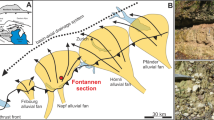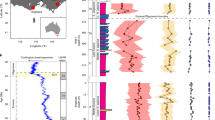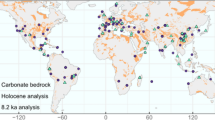Abstract
Marine and continental records1 show an abrupt negative shift in carbon isotope values at ∼55.8 Myr ago. This carbon isotope excursion (CIE) is consistent with the release of a massive amount of isotopically light carbon into the atmosphere and was associated with a dramatic rise in global temperatures termed the Palaeocene–Eocene thermal maximum (PETM). Greenhouse gases released during the CIE, probably including methane, have often been considered the main cause of PETM warming. However, some evidence from the marine record suggests that warming directly preceded the CIE2,3,4, raising the possibility that the CIE and PETM may have been linked to earlier warming with different origins. Yet pre-CIE warming is still uncertain. Disentangling the sequence of events before and during the CIE and PETM is important for understanding the causes of, and Earth system responses to, abrupt climate change. Here we show that continental warming of about 5 °C preceded the CIE in the Bighorn Basin, Wyoming. Our evidence, based on oxygen isotopes in mammal teeth (which reflect temperature-sensitive fractionation processes) and other proxies, reveals a marked temperature increase directly below the CIE, and again in the CIE. Pre-CIE warming is also supported by a negative amplification of δ13C values in soil carbonates below the CIE. Our results suggest that at least two sources of warming—the earlier of which is unlikely to have been methane—contributed to the PETM.
This is a preview of subscription content, access via your institution
Access options
Subscribe to this journal
Receive 51 print issues and online access
$199.00 per year
only $3.90 per issue
Buy this article
- Purchase on Springer Link
- Instant access to full article PDF
Prices may be subject to local taxes which are calculated during checkout



Similar content being viewed by others
References
Pagani, M., Caldeira, K., Archer, D. & Zachos, J. C. An ancient carbon mystery. Science 314, 1556–1557 (2006)
Sluijs, A. et al. Environmental precursors to rapid light carbon injection at the Palaeocene/Eocene boundary. Nature 450, 1218–1221 (2007)
Thomas, D. J. et al. Warming the fuel for the fire: evidence for the thermal dissociation of methane hydrate during the Paleocene-Eocene thermal maximum. Geology 30, 1067–1070 (2002)
Tripati, A. & Elderfield, H. Deep-sea temperature and circulation changes at the Paleocene-Eocene Thermal Maximum. Science 308, 1894–1898 (2005)
Gingerich, P. D. Environment and evolution through the Paleocene–Eocene thermal maximum. Trends Ecol. Evol. 21, 246–253 (2006)
Wing, S. L. et al. Transient floral change and rapid global warming at the Paleocene-Eocene boundary. Science 310, 993–996 (2005)
Panchuk, K., Ridgwell, A. & Kump, L. R. Sedimentary response to Paleocene-Eocene Thermal Maximum carbon release: a model-data comparison. Geology 36, 315–318 (2008)
Wing, S. L., Bao, H. M. & Koch, P. L. in Warm Climates in Earth History (eds Huber, B. T., MacLeod, K. & Wing, S. L.) 197–237 (Cambridge University Press, 2000)
Fricke, H. C., Clyde, W. C., O'Neil, J. R. & Gingerich, P. D. Evidence for rapid climate change in North America during the latest Paleocene thermal maximum: oxygen isotope compositions of biogenic phosphate from the Bighorn Basin (Wyoming). Earth Planet. Sci. Lett. 160, 193–208 (1998)
Koch, P. L. et al. in Causes and Consequences of Globally Warm Climates in the Early Paleogene (eds Wing, S. L., Gingerich, P. D., Schmitz, B. & Thomas, E.) 369, 49–64 (Geological Society of America Special Paper, 2003)
Balasse, M., Smith, A. B., Ambrose, S. H. & Leigh, S. R. Determining sheep birth seasonality by analysis of tooth enamel oxygen isotope ratios: the Late Stone Age site of Kasteelberg (South Africa). J. Archaeol. Sci. 30, 205–215 (2003)
Kohn, M. J. Predicting animal δ18O: accounting for diet and physiological adaptation. Geochim. Cosmochim. Acta 60, 4811–4829 (1996)
Bryant, J. D. & Froelich, P. N. A model of oxygen isotope fractionation in body water of large mammals. Geochim. Cosmochim. Acta 59, 4523–4537 (1995)
Koch, P. L., Zachos, J. C. & Dettman, D. L. Stable isotope stratigraphy and paleoclimatology of the Paleogene Bighorn Basin (Wyoming, USA). Palaeogeogr. Palaeoclimatol. Palaeoecol. 115, 61–89 (1995)
Cerling, T. E. & Harris, J. M. Carbon isotope fractionation between diet and bioapatite in ungulate mammals and implications for ecological and paleoecological studies. Oecologia 120, 347–363 (1999)
Secord, R., Wing, S. L. & Chew, A. Stable isotopes in early Eocene mammals as indicators of forest canopy structure and resource partitioning. Paleobiology 34, 282–300 (2008)
Dansgaard, W. Stable isotopes in precipitation. Tellus 16, 436–468 (1964)
Fricke, H. C. & O'Neil, J. R. The correlation between 18O/16O ratios of meteoric water and surface temperature: its use in investigating terrestrial climate change over geologic time. Earth Planet. Sci. Lett. 170, 181–196 (1999)
Kraus, M. J. & Riggins, S. Transient drying during the Paleocene–Eocene Thermal Maximum (PETM): analysis of paleosols in the Bighorn Basin, Wyoming. Palaeogeogr. Palaeoclimatol. Palaeoecol. 245, 444–461 (2007)
Levin, N. E. et al. A stable isotope aridity index for terrestrial environments. Proc. Natl Acad. Sci. USA 103, 11201–11205 (2006)
Wilf, P. Late Paleocene-early Eocene climate changes in southwestern Wyoming: paleobotanical analysis. Geol. Soc. Am. Bull. 112, 292–307 (2000)
Bowen, G. J. et al. in Paleocene-Eocene Stratigraphy and Biotic Change in the Bighorn and Clarks Fork Basins, Wyoming (ed. Gingerich, P. D.) 73–88 (Univ. of Michigan Papers on Paleontology 33, 2001)
Bowen, G. J. et al. A humid climate state during the Palaeocene/Eocene thermal maximum. Nature 432, 495–499 (2004)
Koch, P. L. Isotopic reconstruction of past continental environments. Annu. Rev. Earth Planet. Sci. 26, 573–613 (1998)
Wang, Y. & Cerling, T. E. A model of tooth and bone diagenesis: implications for paleodiet reconstruction from stable isotopes. Palaeogeogr. Palaeoclimatol. Palaeoecol. 107, 281–289 (1994)
Storey, M., Duncan, R. A. & Swisher, C. C. Paleocene-Eocene Thermal Maximum and the opening of the northeast Atlantic. Science 316, 587–589 (2007)
Svensen, H. et al. Release of methane from a volcanic basin as a mechanism for initial Eocene global warming. Nature 429, 542–545 (2004)
Dickens, G. R., O'Neil, J. R., Rea, D. K. & Owen, R. M. Dissociation of oceanic methane hydrate as a cause of the carbon isotope excursion at the end of the Paleocene. Paleoceanography 10, 965–971 (1995)
Kurtz, A. C. et al. Early Cenozoic decoupling of the global carbon and sulfur cycles. Paleoceanography 18 10.1029/2003PA000908 (2003)
Longinelli, A. & Nuti, S. Revised phosphate-water isotopic temperature scale. Earth Planet. Sci. Lett. 19, 373–376 (1973)
Secord, R. et al. Geochronology and mammalian biostratigraphy of middle and upper Paleocene continental strata, Bighorn Basin, Wyoming. Am. J. Sci. 306, 211–245 (2006)
Acknowledgements
We thank D. C. Fisher, G. F. Gunnell, G. R. Smith, L. Wingate, D. L. Dettman, W. J. Sanders, D. L. Fox, P. L. Koch, R. E. Blake, H. C. Fricke, G. J. Bowen, J. I. Bloch, F. A. Smith-McInerney, B. H. Wilkinson, T. Huston, R. Lange and Y. Zhang for their help and advice; S. L. Wing, A. Rountrey, and A. R. Wood for manuscript comments; I. S. Zalmout, D. M. Boyer, and P. Rose for field support. This work was supported by grants from the American Chemical Society (to P.D.G.), the National Science Foundation (to P.D.G.), the Geological Society of America (to R.S.), and the University of Michigan Department of Geological Sciences (to R.S.).
Author information
Authors and Affiliations
Contributions
R.S. sampled and pretreated enamel and ganoine, developed modified techniques for precipitation of Ag3PO4 with K.G.M., did most of the analytical work, and wrote most of this paper. P.D.G. provided specimens, primary stratigraphic data, guidance, and field support. K.G.M. and K.C.L. provided laboratory support and assistance interpreting results. All authors discussed the results and commented on the manuscript.
Corresponding author
Ethics declarations
Competing interests
The authors declare no competing financial interests.
Supplementary information
Supplementary Information
This file contains Supplementary Text and Data, Supplementary Tables 1-3, Supplementary Methods and additional references. (PDF 269 kb)
Rights and permissions
About this article
Cite this article
Secord, R., Gingerich, P., Lohmann, K. et al. Continental warming preceding the Palaeocene–Eocene thermal maximum. Nature 467, 955–958 (2010). https://doi.org/10.1038/nature09441
Received:
Accepted:
Published:
Issue Date:
DOI: https://doi.org/10.1038/nature09441
This article is cited by
-
A study on benthic molluscs and stable isotopes from Kutch, western India reveals early Eocene hyperthermals and pronounced transgression during ETM2 and H2 events
Swiss Journal of Palaeontology (2022)
-
Two massive, rapid releases of carbon during the onset of the Palaeocene–Eocene thermal maximum
Nature Geoscience (2015)
-
New ambrosia beetles (Coleoptera: Curculionidae: Platypodinae) from Miocene Mexican and Dominican ambers and their paleobiogeographical implications
Organisms Diversity & Evolution (2015)
-
Reconciliation of marine and terrestrial carbon isotope excursions based on changing atmospheric CO2 levels
Nature Communications (2013)
Comments
By submitting a comment you agree to abide by our Terms and Community Guidelines. If you find something abusive or that does not comply with our terms or guidelines please flag it as inappropriate.



